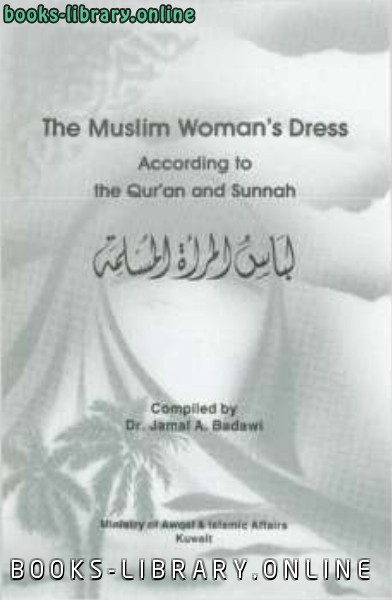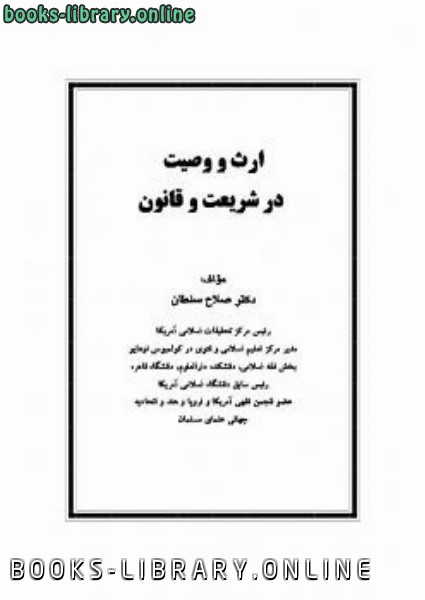كتاب The Muslim Woman rsquo s Dress
To some as a subject the M uslim w om en's dress may sound trivial. The shari'ah, however, assigns it moral, social, and legal dimensions. One basic requirem ent to be a true believer according to the Q ur'an is to make one's opinions, feelings, and inclinations subservient to w hatever Allah and his Messenger have decided: It is not befitting for a believer, man or woman, when a matter has been decided by Allah and His Apostle, to have any option about their decision: if any one disobeys Allah and His Apostle, he is indeed on a clearly wrong path. S u ra t-u l-A h za b (33) 36 Placing, therefore, one's personal opinions, feelings, or inclinations above or at the same level as the commandments of Allah is the ultim ate of human price and vanity. This means, in effect, that a mortal is responding to Allah'sguidance saying: "O my creator! Your Law is Your Own opinion. I nave my own opinion, and I know best w hat is good for m e.” This attitude is befitting for unbelievers and hypocrites, but not for a believer no m atter how imperfect (all are!) one may be in im plem enting Islam in one's life.2 The exposition of truth in an honest and straight forward w ay may thus cause some unease even to good and sincere M uslim s. It may seem safer and diplom atic to avoid the issue altogether, or to present it in a diluted and vague way. It is even safer and more diplom atic' to explicitly or im plicitly condone each others' infractions, to help each other find excuses and to rationalize our disobedience to Allah subhanahu w ata'ala. This attitude is neither new nor it is w ithout consequences. As the Q ur'an presents it: The Muslim Woman’s Dress according to the Qur’an and Sunnah compiled by Dr. Jamal A. Badawi To some as a subject the Muslim women’s dress may sound trivial. The shari’ah, however, assigns it moral, social, and legal dimensions. One basic requirement to be a true believer according to the Qur’an is to make one’s opinions, feelings, and inclinations subservient to whatever Allah and his Messenger decided.جمال بدوي - ❰ له مجموعة من الإنجازات والمؤلفات أبرزها ❞ الفاطمية دولة التفاريح والتباريح ❝ ❞ مسرور السياف واخوانه ❝ ❞ Gender Equity in Islam ❝ ❞ الشيعة قادمون .. ❝ ❞ The Muslim Woman rsquo s Dress ❝ ❞ محمدعلى واولاده بناة مصر الحديثة ❝ ❞ The Muslim Woman 039 s Dress According to The Quran and Sunnah ❝ ❞ مسرور السياف واخوانه ❝ الناشرين : ❞ دار الشروق للنشر والتوزيع: مصر - لبنان ❝ ❱
من كتب إسلامية بلغات أخرى - مكتبة كتب إسلامية.

قراءة كتاب The Muslim Woman rsquo s Dress أونلاين
معلومات عن كتاب The Muslim Woman rsquo s Dress:
To some as a subject the M uslim w om en's dress may sound trivial.
The shari'ah, however, assigns it moral, social, and legal dimensions.
One basic requirem ent to be a true believer according to the Q ur'an
is to make one's opinions, feelings, and inclinations subservient to
w hatever Allah and his Messenger have decided:
It is not befitting for a believer, man or woman, when a matter
has been decided by Allah and His Apostle, to have any option
about their decision: if any one disobeys Allah and His Apostle,
he is indeed on a clearly wrong path.
S u ra t-u l-A h za b (33) 36
Placing, therefore, one's personal opinions, feelings, or
inclinations above or at the same level as the commandments of
Allah is the ultim ate of human price and vanity. This means, in effect,
that a mortal is responding to Allah'sguidance saying: "O my creator!
Your Law is Your Own opinion. I nave my own opinion, and I know
best w hat is good for m e.” This attitude is befitting for unbelievers
and hypocrites, but not for a believer no m atter how imperfect (all
are!) one may be in im plem enting Islam in one's life.2
The exposition of truth in an honest and straight forward w ay may
thus cause some unease even to good and sincere M uslim s. It may
seem safer and diplom atic to avoid the issue altogether, or to present
it in a diluted and vague way. It is even safer and more diplom atic' to
explicitly or im plicitly condone each others' infractions, to help
each other find excuses and to rationalize our disobedience to Allah
subhanahu w ata'ala. This attitude is neither new nor it is w ithout
consequences. As the Q ur'an presents it:
The Muslim Woman’s Dress according to the Qur’an and Sunnah compiled by Dr. Jamal A. Badawi To some as a subject the Muslim women’s dress may sound trivial. The shari’ah, however, assigns it moral, social, and legal dimensions. One basic requirement to be a true believer according to the Qur’an is to make one’s opinions, feelings, and inclinations subservient to whatever Allah and his Messenger decided.
للكاتب/المؤلف : جمال بدوي .
دار النشر : .
عدد مرات التحميل : 3685 مرّة / مرات.
تم اضافته في : الأربعاء , 27 مارس 2019م.
حجم الكتاب عند التحميل : 15.9 ميجا بايت .
تعليقات ومناقشات حول الكتاب:
tro d u c tio n ................................................................................................... 3
Requirements in D re s s ............................................................................... 5
1. Extent of Covering ...................................................................... 5
2. Looseness....................................................................................... 7
3. T h ic k n e s s ....................................................................................... 8
4. Overall A p p e a ra n ce ..................................................................... 8
Requirements of M uslim M en's Clothing ............................................. 10
C o n clu sio n ..................................................................................................... 11
M ajor R eferences.........................................................................................
To some as a subject the M uslim w om en's dress may sound trivial.
The shari'ah, however, assigns it moral, social, and legal dimensions.
One basic requirem ent to be a true believer according to the Q ur'an
is to make one's opinions, feelings, and inclinations subservient to
w hatever Allah and his Messenger have decided:
It is not befitting for a believer, man or woman, when a matter
has been decided by Allah and His Apostle, to have any option
about their decision: if any one disobeys Allah and His Apostle,
he is indeed on a clearly wrong path.
S u ra t-u l-A h za b (33) 36
Placing, therefore, one's personal opinions, feelings, or
inclinations above or at the same level as the commandments of
Allah is the ultim ate of human price and vanity. This means, in effect,
that a mortal is responding to Allah'sguidance saying: "O my creator!
Your Law is Your Own opinion. I nave my own opinion, and I know
best w hat is good for m e.” This attitude is befitting for unbelievers
and hypocrites, but not for a believer no m atter how imperfect (all
are!) one may be in im plem enting Islam in one's life.2
The exposition of truth in an honest and straight forward w ay may
thus cause some unease even to good and sincere M uslim s. It may
seem safer and diplom atic to avoid the issue altogether, or to present
it in a diluted and vague way. It is even safer and more diplom atic' to
explicitly or im plicitly condone each others' infractions, to help
each other find excuses and to rationalize our disobedience to Allah
subhanahu w ata'ala. This attitude is neither new nor it is w ithout
consequences. As the Q ur'an presents it:
Curses were pronounced on those among the children of Israel
w ho rejected faith, by the tongue of Dawood [David] and of Esa
[Jesus] the son of Mary: because they disoebeyed and persisted
in excesses.
Nor did they (usually) forbid one another the iniquities which
they committed: evil indeed were the deeds w hich they did.
S u ra t-u l-M a 'id a h (5) 81 -82
THE FIRST REQ UIREM ENT: E xtent of C overing
The dress must cover the whole body except for the areas
specifically exempted. The Qur'an states:
Say to the believing men that they should lower their gaze and
guard their modesty: that w ill make for greater purity for them:
And A llah is w ell acquainted w ith all that they do.
And say to the believing women that they should lower their
gaze and and guard their modesty; that they should not display
their beauty and ornam ents except w hat (must ordinarily)
appear thereof; that they should draw their veils over their
bosoms and not display their beauty except to their husbands,
their fathers, their husbands' fathers, their sons, their
husbands' sons,their brothers or their brothers' sons, or their
sisters' sons, or their wom en, or the slaves whom their right
hands possess, or male servants free of physical needs, or small
children w ho have no sense of the shame of sex; and that they
should not strike their feet in order to draw attention to their
hidden ornaments. And O you believers! Turn all toward Allah
that you may attain bliss.
S u ra t-u n -N u r (24) 30-31
These ayahs contain, among other thing, tw o mam injunctions:
1 A M uslim wom an should not display her beauty and
adornm ent (zeenah) except for “ that w hich must ordinarily appear of
it” 3 (ma dhahara minha), or “ that w hich is apparent."4
The word zeenah6 lends itself to tw o related meanings: a) natural
or bodily beauty,6 and, b) acquired adornm ent such as rings,
bracelets, and clothes.
The part of zeenah, exempted from the above injunction, was
interpreted in two ways:
a. The face and the hands. This is the interpretation of the
m ajority of the jurists, past and present.7 This interpretation is
confirm ed by ijm a ' (consensus) that a M uslim wom an is allowed by
Islam to uncover her face and hands during pilgrim age and even
during the prayers, w hile the rest of her body is regarded as 'a w ra h
(that w hich should be covered).8 This interpretation is based on the
authority of Prophet M uham m ad (A llah's blessing be upon him),
especially the h a d ith in w hich he says:
". . . If the wom an reaches the age of puberty. No (part of her
body) should be seen but this — and he pointed to his face and
hands."
b. W hatever appears of the w o m a n s body ow ing to
uncontrollable factors such as the blowing of the w ind, or out of
necessity such as the bracelets or even the outer clothes
themselves.9
2. The headcovers (k h u m u r) should be draw n over the neck slits
(ju yo o b ). Khum ur is the plural of the Arabic w ord "k h im a r" w hich
means a headcover.10 Juyoob is the plural of the Arabic w ord "ja iy b "
(a derivative of jaw b or cutting) refers to the neck slit (of the dress).
This means that the headcover should be draw n so as to cover not
only the hair, but it should also be draw n over the neck and to be
extended so as to cover the bosom.
THE SECO ND R EQ UIREM ENT: Looseness
The dress m ust be loose enough so as not to describe the shape of a
wom an s body. This is consistent w ith the intent of the 'ayahs cited
above (24: 30-31) and is surely a crucial aspect of hiding zeenah.
Even m oderately-tight clothes which cover the whole body do
describe the shape of such attractive parts of the wom an's body as
the bustline, the waist, the buttocks, the back and the thighs. If these
are not part of the natural beauty or zeenah w hat else is?
Prophet M uham m ad (pbuh) once received a thick garm ent as a gift.
He gave it to Osamah b. Zayd, who in turn gave it to his w ife. W hen
asked by the Prophet w hy he did not wear it, Osamah indicated that
he gave it to his w ife. The Prophet then said to Osamah “ ask her to
use a gho la la h .uxu under it (the garment) for I fear that it (the
garment) may describe the size of her bones."11 The w ord g h o la la h in
Arabic means a thick fabric w orn under the dress to prevent it from
describing the shape of the body
A highly desirable w ay of concealing the shape of the body is to
w ear a cloak over the garm ent. The Prophet (pbuh), however.
indicated that if the w om an's dress meets the Islamic standards it
suffices (w ithout a cloak) even for the validity of prayers.12
THE TH IR D REQ UIREM ENT: Thickness
The dress should be thick enough so as not to show the color of the
skin it covers, or the shape of the body w hich it is supposed to hide.
The purpose o f 'ayah (24:31) is to hide the M uslim w om en's body
except m a dhahara m in h a (the face and hands). It is obvious that this
purpose cannot be served if the dress is thin enough so as to reveal
the color of the skin or the shape or beauty of the body. This is
eloquently explained by Prophet M uham m ad (pbuh): "In later
(generations) of my um m ah there w ill be wom en w ho w ill be dressed
but naked. On top of their heads(what looks) like camel humps. Curse
them for they are truly cursed.” In another version he added that they
"w ill not enter into paradise or (even) get a sm ell of it.” 13
At one occasion Asm a' (daughter of Abu-Bakr) was visiting her
sister A ishah,w ife of the Prophet. W hen he noted that Asm a'sdress
was not thick enough he turned his face away in anger and said, "If
the wom an reaches the age of puberty, no part of her body should be
seen, but this, and he pointed to his face and his hands."u
THE FOURTH REQ UIREM ENT: Overall Appearance
The dress should not be such that it attracts m en's attention to the
w om an's beauty. The Q ur'an clearly prescribes the requirem ents of
the wom an's dress for the purpose of concealing zeenah
(adornment). How could such zeenah be concealed if the dress is
designed in a way that it attracts m en's eyes to the woman?
This is w hy the Q ur'an addressing the Prophet s wives as the
examples for M uslim wom en says
"Bedizen not yourselves w ith the bedizenment of the Time of
Ignorance. . . " 15
A dditional R equirem ents'6
In addition to the above four m ain and clearly spelled out
requirem ents, there are other requirem ents whose specific
applications may vary w ith tim e and location. These include:
1. The dress should not be sim ilar to w hat is known as a male
costume. Ibn Abbas narrated that "The Prophet (pbuh) cursed the
men w ho act like wom en and the wom en w ho act like m e n ."17
2. It should not be sim ilar to w hat is known as the costume of
unbelievers. This requirem ent is derived from the general rule of
Shari'ah that M uslim s should have their distinct personality and
should d iffe re n tia te th e ir practices and appearance from
unbelievers.18
3. It should not be a dress of fame, pride and vanity Such fame
may be sought by wearing an excessively fancy dress as a status
symbol or an excessively ragged dress to gain others' adm iration of
one s selflessness. Both motives are improper by Islamic standards.
The Prophet (pbuh) says:
"W hoever wears a dress of fame in this world, Allah w ill clothe
him w ith a dress of hum iliation in the day of resurrection, then
set it a fire
The Muslim Woman’s Dress according to the Qur’an and Sunnah compiled by Dr. Jamal A. Badawi To some as a subject the Muslim women’s dress may sound trivial. The shari’ah, however, assigns it moral, social, and legal dimensions. One basic requirement to be a true believer according to the Qur’an is to make one’s opinions, feelings, and inclinations subservient to whatever Allah and his Messenger decided.
 مهلاً !
مهلاً !قبل تحميل الكتاب .. يجب ان يتوفر لديكم برنامج تشغيل وقراءة ملفات pdf
يمكن تحميلة من هنا 'تحميل البرنامج'

نوع الكتاب : pdf.
اذا اعجبك الكتاب فضلاً اضغط على أعجبني و يمكنك تحميله من هنا:


كتب اخرى في كتب إسلامية بلغات أخرى

Pautas para la crianza de los ni ntilde os PDF
قراءة و تحميل كتاب Pautas para la crianza de los ni ntilde os PDF مجانا

شیطان کی انسان دشمنی انتباہ اوربچاؤ PDF
قراءة و تحميل كتاب شیطان کی انسان دشمنی انتباہ اوربچاؤ PDF مجانا

Sepuluh Kaidah Penting Tentang istiqomah PDF
قراءة و تحميل كتاب Sepuluh Kaidah Penting Tentang istiqomah PDF مجانا

راهنمايی zwnj های ارزشمند درباره لباس و آرايش زنان PDF
قراءة و تحميل كتاب راهنمايی zwnj های ارزشمند درباره لباس و آرايش زنان PDF مجانا






